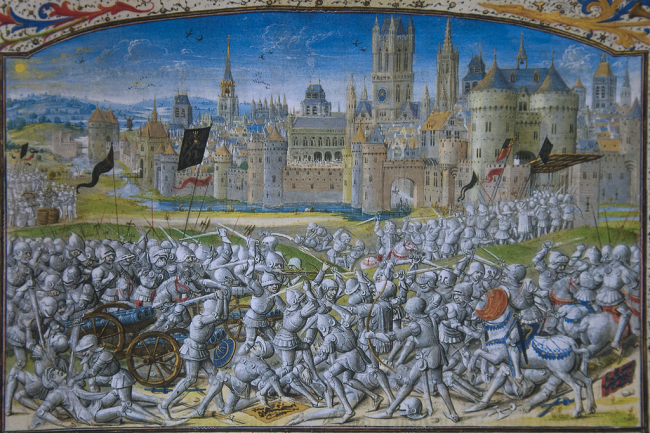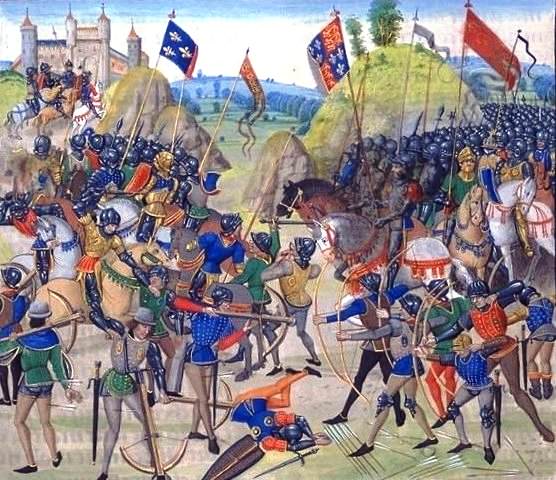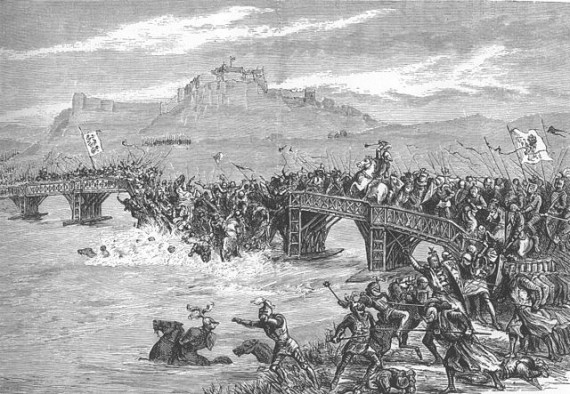Top 10 Strangest Battles of the Middle Ages
1. Combat of the Thirty – 26 March 1351
During the wars between the English and the French in the 14th century (this time over who would rule the Duchy of Brittany), two opposing commanders challenged each other to a battle. They agreed to each bring 30 men – knights and squires – to a pre-determined battlefield, and fight until one side was defeated. The French and English fought for several hours, while a crowd watched and refreshments were served. At one point they stopped the battle for a break and to allow the wounded to be treated. In the end, the French won the battle, after 9 English combatants were killed and the rest surrendered.2. Battle of Zappolino – 15 November 1325
The only battle of the so-called ‘War of the Oaken Bucket’ – which started when soldiers from the Italian town of Modena snuck into the neighbouring city of Bologna, where they stole a bucket from the main city well. The Bolognese declared war on Modena after they refused to return the bucket. An army of 32000 men from Bologna marched on Modena, which was defended by a force of 7000, but after a fierce battle the Bolognese fled back to their city, with the Modenese chasing them the entire way. In another version of these events, it was during this battle that the bucket was taken and flaunted by Modena as a spoil of war. In any case, you can still see the bucket in Modena, hanging in the main bell tower of the city.
3. Battle of Lake Peipus – 5 April 1242
When Prince Alexander Nevsky of Novgorod was faced with an invasion from the Teutonic Knights in present-day Estonia, he chose for a battlefield the frozen Lake Peipus. The slippery surface made fighting difficult for the Teutonic Knights, and after several hours of fighting they were forced to retreat. However, the warmer spring weather had made the ice weak, and when the knights moved across the lake they crashed through, with hundreds of them drowning.
4. Battle of Beverhoutsveld – 3 May 1382

An army from the Belgium town of Ghent had marched on the nearby city of Bruges. The men of Bruges had just finished celebrated the annual Procession of the Holy Blood, an important religious holiday for the town, and many of them had been drinking heavily that day. The two forces lined up outside the city and, after a short battle, the army from Ghent was victorious and captured Bruges.
5. Battle of Fimreite – 15 June 1184
In this naval battle, Norway’s King Magnus Erlingsson brought 26 ships against a fleet of 14 vessels commanded by the challenger to his throne Sverre Sigurdsson. Sverre had his ships attack Magnus’ ships one at a time, forcing the enemy fighters to jump to their remaining ships. Eventually, Magnus’ ships became so overcrowded that they sunk. The Norwegian king went down with the last ship, and Sverre would go on to rule Norway for eighteen years.
6. Battle of Stirling Bridge – 11 September 1297
The famous victory by the Scottish leader William Wallace can be seen as a comedy-of-errors by the English side. The English army began the attack and then withdrew because their commander, John de Warenne, had overslept and had not yet reached the battlefield. Once the English army got moving again, part of their force crossed over Stirling Bridge and then the Scottish army cut them off. Nearly the entire English vanguard were slaughtered while the rest of their army helplessly looked on. Afterwards the Scottish victors took the body of the English second-in-command, Hugh de Cressingham, and cut the skin into pieces so they could give it out as souvenirs for the men.
7. Battle of the Helgeå – 1026
In this battle the kings of Norway and Sweden allied with each other to face King Cnut of England and Denmark. Cnut brought his fleet up to the mouth of the Swedish river of Helgeå, where the Norwegians had built a dam upriver. When they learned that Cnut had come there, the Norwegians smashed open the dam, releasing a flood of waters which smashed into the Danish ships. However, Cnut’s flagship was able to survive and fend off the attacks from the Swedes and Norwegians.
8. Battle of Covadonga – Either 718 or 722
After an Islamic army had conquered most of Iberia in 711, a Visigothic nobleman named Pelagius led the resistance to the Umayyad Caliphate from the mountains of Asturias. When a Muslim army came into the mountains to track down Pelagius and his men (one source calls the group nothing more than ‘thirty wild donkeys’), the Christian soldiers surprised them from caves and the mountain slopes and defeated the attackers. Christian sources claim that tens of thousands of Muslims were killed, while Moorish accounts state that fight was just a small skirmish.
9. Battle of Crecy – 26 August 1346

The most unusual thing about this battle – a major victory by the English against the French during the Hundred Years War – was when John of Bohemia, King of Bohemia, entered the battle on the French side, despite being blind. During the fighting he told his companions: “Sirs, ye are my men, my companions and friends in this journey: I require you bring me so far forward, that I may strike one stroke with my sword.” They all tied their horses together and rode against the English line. The next day the bodies of the king and his men were all found together.
10. Battle of Bremule – 20 August 1119
This battle, between Henry I of England and Louis VI the Fat of France is unusual in how few people were killed in it. The chronicler Orderic Vitalis explains, “I have been told that in the battle of the two kings, in which about nine hundred knights were engaged, only three were killed. They were all clad in mail and spared each other on both sides, out of fear of God and fellowship in arms; they were more concerned to capture than to kill the fugitives. As Christian soldiers they did not thirst for the blood of their brothers, but rejoiced in a just victory given by God, for the good of holy Church and the peace of the faithful.”

